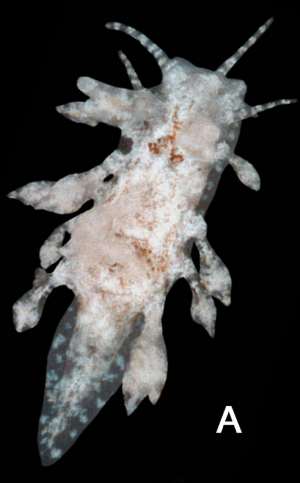
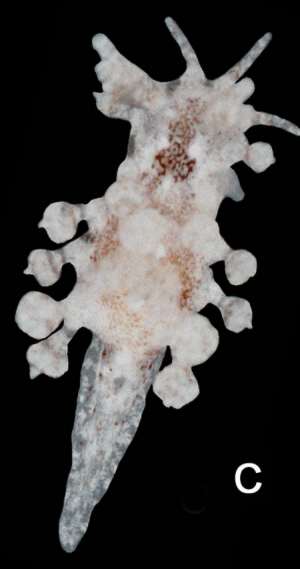
Okenia impexa
Marcus, 1957
Order: NUDIBRANCHIA
Suborder: DORIDINA
Superfamily: ANADORIDOIDEA
Family: Goniodorididae
DISTRIBUTION
Western Atlantic from Brazil to North Carolina, USA. Also reported from the western Mediterranean (Schmekel, 1979) and from Cape Verde, eastern Atlantic (Valdes & Ortea, 1995)
PHOTO
Upper right: 3mm. Dredged from sand and scattered grass in 2.5m, lee side of Whale Cay. June 28, 1997. Lower right: 4mm. On Sargassum attached to the substrate in 1m, Guana Cay. August 12, 2003. Both locations in Abaco, Bahamas. Photos: Colin Redfern.
Animal translucent with opaque white and brown patching all over body. Usually a large reticulate brown patch behind the rhinophores. It is characterised by four long tapering tentacular papillae at the anterior end around the mantle edge - almost polycerid like - and a series of five or six lateral mantle papillae down each side on the mantle edge. These papillae have a characteristic swelling in the upper third of their length giving them a spindle like appearance, quite different from that of the anterior 4 papillae. It grows to approx 8 mm long alive.
The radula is typical for the goniodorids with a formula of 1.1.0.1.1. The small outer teeth have 3 long pointed cusps.
-
Marcus, E. (1957) On Opisthobranchia from Brazil (2). Zoological Journal of the Linnean Society, 43(292), 390-486.
-
Redfern. C., (2001) Bahamian Seashells: a Thousand Species from Abaco, Bahamas. Bahamianseashells.com Inc: Boca Raton. 1-280.
-
Schmekel, L. (1979) First record of Okenia impexa Marcus, 1957 from the Western Atlantic in the Mediterranean. The Veliger 21: 355-360.
-
Valdés, Á. & Ortea, J. (1995) Revised taxonomy of some species of the genus Okenia Menke, 1830 (Mollusca: Nudibrancia) from the Atlantic Ocean, with the description of a new species. The Veliger, 38(3), 223-234.
Rudman, W.B., 2004 (December 22) Okenia impexa Marcus, 1957. [In] Sea Slug Forum. Australian Museum, Sydney. Available from http://www.seaslugforum.net/find/okenimpe
Related messages
Re: Okenia cupella? from French Mediterranean
June 14, 2006
From: Marina P. Ossokine
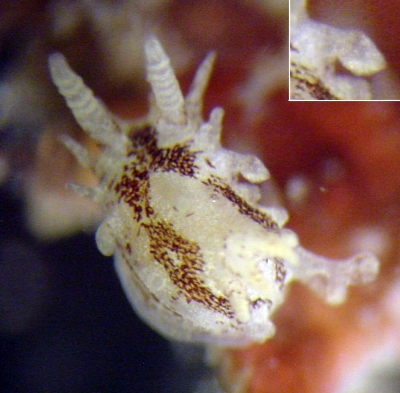
Concerning message #16803:
Dear Bill,
Thank you for your opinion on this specimen.
In fact, all these photos are of one same animal. It has very few lateral papillae. And here are the best photos of these papillae I have.
Cheers,
Marina.
nembro@nembro.info
Poddubetskaia Ossokine, M., 2006 (Jun 14) Re: Okenia cupella? from French Mediterranean. [Message in] Sea Slug Forum. Australian Museum, Sydney. Available from http://www.seaslugforum.net/find/16864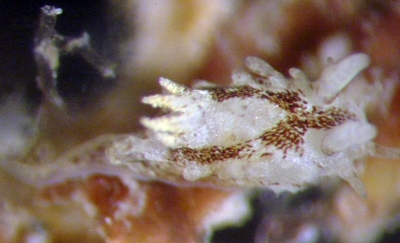
Thanks Marina,
These photos confirm in my mind that this is Okenia impexa rather than O. culpella. They also illustrate how 'less than perfect' photos often contain very useful information. There is at least one lateral papilla which shows the fairly characteristic shape of this species. I thought I could see a yellowish tinge in parts of your earlier photos and in your new photos, patches of creamy yellow are quite evident on the gills and partsof the mantle. Both Marcus (1957) and Schmekel (1979) mention a yellowish coloration. Schmekel's black & white photos of a Mediterranean animal, look very similar to your photo in general shape and arrangement of the brown patching.
Best wishes,
Bill Rudman
Okenia cupella? from French Mediterranean
June 10, 2006
From: Marina P. Ossokine
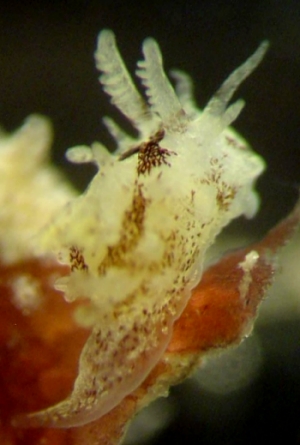
Dear Bill,
Here is another Okenia species, but from the Mediterranean this time. I think this tiny animal fits all the external distinctive futures of Okenia cupella, as described in Valdes & Ortea (1995) paper :
- body colour : pale cream with an irregular brown spotted pigmentation
- 4 long appendages on the velum
- presence of a single papillae in the middle of the notum
- club-shaped papillae, pale cream in colour with small pale brown spots
- rhinophores with cuplike lamellae, 7 according to Valdes & Ortea but only 6 in my animal, maybe because it is a juvenile
- 4 branchial gills
- distribution : Okenia cupella has been reported from Banyuls and it is only about 50 km south of Port-Leucate
Attached here photos show well all these characteristics.
I found this specimen on a mixed fauna, so I couldn't associate it to any bryozoan, and I don't have any clue for the food. Unfortunately I can't check the radula either, because I don't have this specimen no more.
Locality: 'La digue', Port-Leucate, 3m, France, Mediterranean, 16 May 2005. Length: 3mm. Photographer: Marina Poddubetskaia Ossokine.
I have never seen a colour photo of this species, so I'd like to have your opinion on this ID, please.
Thank you in advance.
Best wishes,
Marina.
Nembro website
nembro@nembro.info
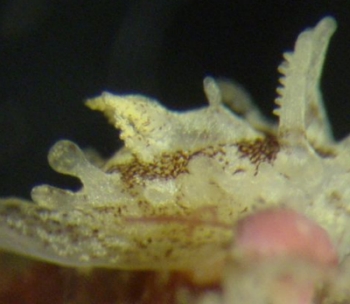
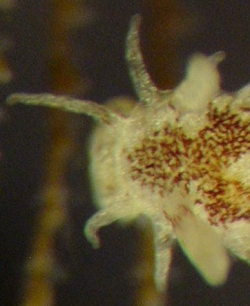
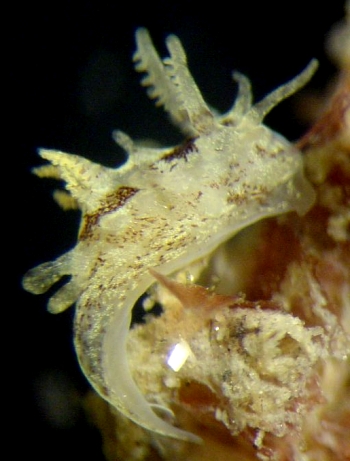
Dear Marina,
Thanks for these interesting photos. Your animal could be one of two western Atlantic species, which have also been reported from the eastern Atlantic - O. cupella, and O. impexa. Valdes & Ortea (1995) describe specimens of both, O cupella from Spain, and O. impexa from Cuba and Cape Verde Islands. Although they cite earlier records of O. cupella from the western Mediterranean, they consider their record of O. impexa to be the first from the eastern Atlantic, however Schmekel (1979) had already described specimens from Banyuls and Naples in the Mediterranean.
In comparing the two species, Valdes & Ortea note that the major external difference is the shape of the lateral papillae - 'pike-shaped' in O. impexa, and club-shaped in O. cupella. From my experience with species of Okenia I find the shape of the lateral papillae to be a fairly risky character to use because the shape of the papillae is quite plastic in living animals, and also in your photos I can't see any of the lateral papillae which are the 'pike-shaped' ones.
Looking at the original descriptions of the two species, two other external characters seem to be quite important. Firstly, in general shape O. cupella has a narrow elongate body and the mantle edge, between the lateral papillae seems to form a 'webbing'. O. impexa, on the other hand is a shorter, higher animal and the lateral papillae seem to arise directly from the body wall with no remnant mantle skirt between them. The other important difference seems to be in colour. From my reading of the various descriptions, O. cupella seems to have scattered brown spots, especially in the mid dorsal area, while O. impexa has a pattern of brown 'patches' which Ortea and Valdes described as a 'dark brown patch .... which bears pale spots' and Marcus (1957) describes as 'a net of superficial brown pigment forming patches ...'
I am pretty sure your animals are Okenia impexa. If you have a photo showing the shape of the lateral papillae from above or below it would be nice.
- Marcus, E. (1957) On Opisthobranchia from Brazil (2). Journal of the Linnean Society of London, Zoology 43: 390-486.
- Valdes, A. & Ortea, J. (1995) Revised taxonomy of some species of the genus Okenia Menke, 1830 (Mollusca: Nudibranchia) from the Atlantic Ocean, with the description of a new species. The Veliger, 38(3): 223-234.
- Schmekel, L. (1979) First record of Okenia impexa Marcus, 1957 from the Western Atlantic in the Mediterranean. The Veliger 21: 355-360.
- Vogel, R. M. and Schultz, L. P. (1970) Cargoa cupella, new genus and new species of nudibranch from Chesapeake Bay and the generic status of Okenia Menke, Idalia Leuckart and Idalla Orsted. The Veliger 12: 388-393.
Best wishes,
Bill Rudman
